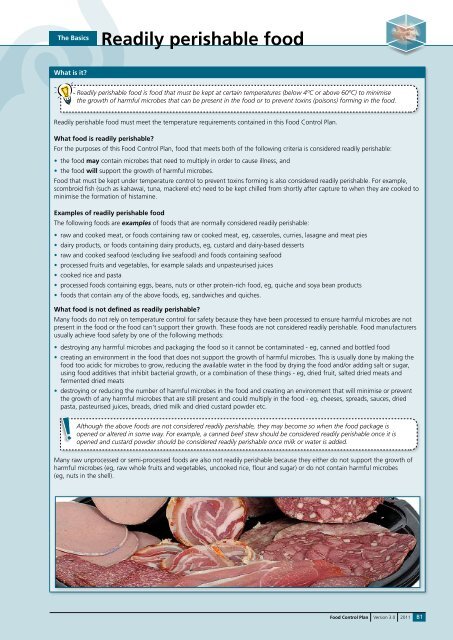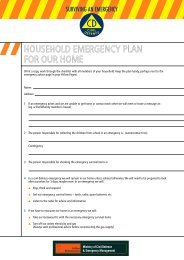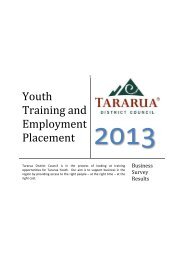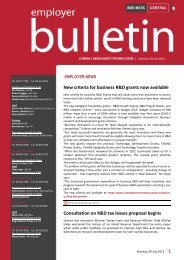Food Control Plan Checklist - Tararua District Council
Food Control Plan Checklist - Tararua District Council
Food Control Plan Checklist - Tararua District Council
- No tags were found...
Create successful ePaper yourself
Turn your PDF publications into a flip-book with our unique Google optimized e-Paper software.
The BasicsReadily perishable foodWhat is it?Readily perishable food is food that must be kept at certain temperatures (below 4ºC or above 60ºC) to minimisethe growth of harmful microbes that can be present in the food or to prevent toxins (poisons) forming in the food.Readily perishable food must meet the temperature requirements contained in this <strong>Food</strong> <strong>Control</strong> <strong>Plan</strong>.What food is readily perishable?For the purposes of this <strong>Food</strong> <strong>Control</strong> <strong>Plan</strong>, food that meets both of the following criteria is considered readily perishable:• the food may contain microbes that need to multiply in order to cause illness, and• the food will support the growth of harmful microbes.<strong>Food</strong> that must be kept under temperature control to prevent toxins forming is also considered readily perishable. For example,scombroid fish (such as kahawai, tuna, mackerel etc) need to be kept chilled from shortly after capture to when they are cooked tominimise the formation of histamine.Examples of readily perishable foodThe following foods are examples of foods that are normally considered readily perishable:• raw and cooked meat, or foods containing raw or cooked meat, eg, casseroles, curries, lasagne and meat pies• dairy products, or foods containing dairy products, eg, custard and dairy-based desserts• raw and cooked seafood (excluding live seafood) and foods containing seafood• processed fruits and vegetables, for example salads and unpasteurised juices• cooked rice and pasta• processed foods containing eggs, beans, nuts or other protein-rich food, eg, quiche and soya bean products• foods that contain any of the above foods, eg, sandwiches and quiches.What food is not defined as readily perishable?Many foods do not rely on temperature control for safety because they have been processed to ensure harmful microbes are notpresent in the food or the food can’t support their growth. These foods are not considered readily perishable. <strong>Food</strong> manufacturersusually achieve food safety by one of the following methods:• destroying any harmful microbes and packaging the food so it cannot be contaminated - eg, canned and bottled food• creating an environment in the food that does not support the growth of harmful microbes. This is usually done by making thefood too acidic for microbes to grow, reducing the available water in the food by drying the food and/or adding salt or sugar,using food additives that inhibit bacterial growth, or a combination of these things - eg, dried fruit, salted dried meats andfermented dried meats• destroying or reducing the number of harmful microbes in the food and creating an environment that will minimise or preventthe growth of any harmful microbes that are still present and could multiply in the food - eg, cheeses, spreads, sauces, driedpasta, pasteurised juices, breads, dried milk and dried custard powder etc.Although the above foods are not considered readily perishable, they may become so when the food package isopened or altered in some way. For example, a canned beef stew should be considered readily perishable once it isopened and custard powder should be considered readily perishable once milk or water is added.Many raw unprocessed or semi-processed foods are also not readily perishable because they either do not support the growth ofharmful microbes (eg, raw whole fruits and vegetables, uncooked rice, flour and sugar) or do not contain harmful microbes(eg, nuts in the shell).<strong>Food</strong> <strong>Control</strong> <strong>Plan</strong> Version 3.0 2011B1







